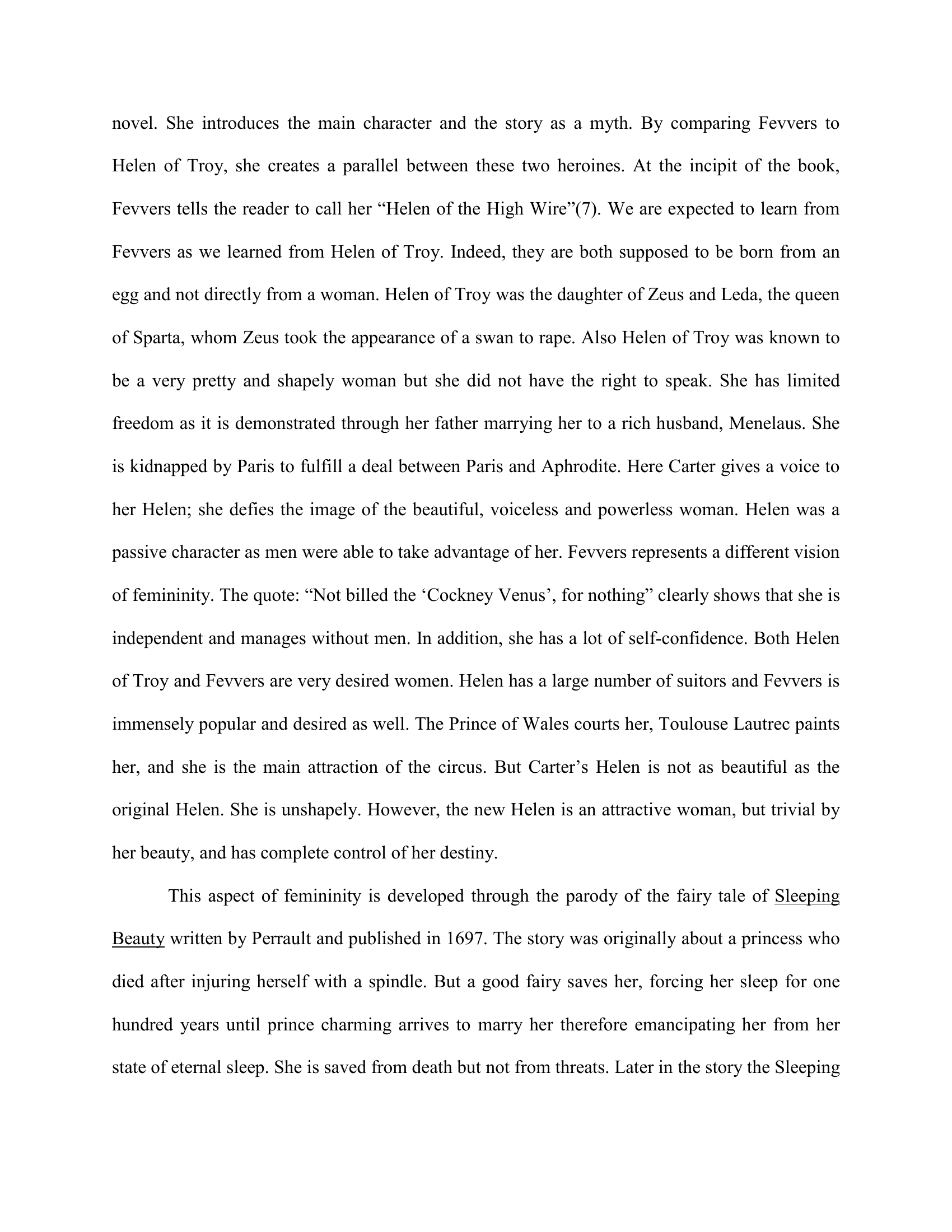Revival of Woman Through Classic Writings
Publié le 18/11/2011
Extrait du document
Nights at the Circus, a novel by Angela Carter was published in 1984. The story is set in 1899, the first moment of the new century. The new century in the book is the background for the construction of a new femininity vision in reality. To demonstrate this, throughout the book Carter rewrites some fairy tales and stories to give them a new purpose. It is a prepared cutoff that Carter sets up. In fact, it is impossible to quote the number of references that Carter uses in her novel but we can easily quote Melville, Shakespeare, Baudelaire, Goethe and many more. The multitude of references in a literature piece is a commonly used technique in literature. Usually writers make references to other works to establish their authority or spread their knowledge.
«
novel.
She introduces the main character and the story as a myth.
By comparing Fevvers to
Helen of Troy, she creates a parallel between these two heroines.
At the incipit of the book,
Fevvers tells the reader to call her “Helen of the High Wire”(7).
We are expected to learn from
Fevvers as we learned from Helen of Troy.
Indeed, they are both supposed to be born from an
egg and not directly from a woman.
Helen of Troy was the daughter of Zeus and Leda, the queen
of Sparta, whom Zeus took the appearance of a swan to rape.
Also Helen of Troy was known to
be a very pretty and shapely woman but she did not have the right to speak.
She has limited
freedom as it is demonstrated through her father marrying her to a rich husband, Menelaus.
She
is kidnapped by Paris to fulfill a deal between Paris and Aphrodite.
Here Carter gives a voice to
her Helen; she defies the image of the beautiful, voiceless and powerless woman.
Helen was a
passive character as men were able to take advantage of her.
Fevvers represents a different vision
of femininity.
The quote: “Not billed the ‘Cockney Venus’, for nothing” clearly shows that she is
independent and manages without men.
In addition, she has a lot of self-confidence.
Both Helen
of Troy and Fevvers are very desired women.
Helen has a large number of suitors and Fevvers is
immensely popular and desired as well.
The Prince of Wales courts her, Toulouse Lautrec paints
her, and she is the main attraction of the circus.
But Carter’s Helen is not as beautiful as the
original Helen.
She is unshapely.
However, the new Helen is an attractive woman, but trivial by
her beauty, and has complete control of her destiny.
This aspect of femininity is developed through the parody of the fairy tale of Sleeping
Beauty written by Perrault and published in 1697.
The story was originally about a princess who
died after injuring herself with a spindle.
But a good fairy saves her, forcing her sleep for one
hundred years until prince charming arrives to marry her therefore emancipating her from her
state of eternal sleep.
She is saved from death but not from threats.
Later in the story the Sleeping.
»
↓↓↓ APERÇU DU DOCUMENT ↓↓↓
Liens utiles
- On the Waterfront On the Waterfront, motion picture about a down-and-out boxer who finds courage to stand up to a corrupt labor union through the friendship of a woman and a priest.
- DAME EN BLANC (La) [The Woman in White]. (résumé & analyse)
- FEMME D’ANDROS (La) [The Woman of Andros]. (résumé)
- The 1960’s and the American Woman: the transition from the “housewife” to the feminist
- Jane, a young woman from England, has found a job in New York. A few days after her arrival she writes to her parents back home

































